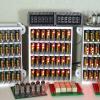Building a Brainfuck translator in TurboAssembler.
To begin with, we will write an interpreter in a high-level language, for example, in Pascal.
Let's write a program that outputs a character whose ascii-code corresponds to the number of +
Therefore, we only need the bf-commands + and .
var
data_mem: array[1..10] of integer; // data array
command_mem: string; // command array
i: integer; // index of command array
j: integer; // index of data array
begin
j:=1;
readln(command_mem);
for i:=1 to length(command_mem) do begin // in the cycle we process the string
if (command_mem[i]='+') then data_mem[j]:= data_mem[j]+1;
if (command_mem[i]='.') then write(chr(data_mem[j]));
end;
end.
bf-code +++++++++++++++++++++++++++++++++. will issue !
(the ascii-code of the symbol ! is 33).
The efficiency of the program can be checked in online ide ideone.com.
Next, replace for operator with goto operator and add the bf-commands — < > .
At the end, we will output the data array data_mem
LABEL prev,next;
var
data_mem: array[1..10] of integer;
command_mem: string;
i,j,k: integer;
begin
j:=1;
i:=1;
readln(command_mem);
prev:
if i>length(command_mem) then goto next;
if (command_mem[i]='+') then data_mem[j]:= data_mem[j]+1;
if (command_mem[i]='-') then data_mem[j]:= data_mem[j]-1;
if (command_mem[i]='>') then j:=j+1;
if (command_mem[i]='<') then j:=j-1;
if (command_mem[i]='.') then write(chr(data_mem[j]));
i:=i+1;
goto prev;
next:
for k:=1 to 10 do begin
write(data_mem[k]);
write(' ');
end;
end.
Next, let's add [ and ]
Add another variable i_stor for bracket [ ] loop.
If the current item passed the check for [ than load i to i_stor (if current item greater than zero).
By processing of the closing bracket ] (if data_mem not equal zero) load the address of the opening bracket [ into i from i_stor
LABEL prev,next;
var
data_mem: array[1..10] of integer;
command_mem: string;
i,j,k: integer;
i_stor: integer;
begin
j:=1;
i:=1;
readln(command_mem);
prev:
if i>length(command_mem) then goto next;
if (command_mem[i]='+') then data_mem[j]:= data_mem[j]+1;
if (command_mem[i]='-') then data_mem[j]:= data_mem[j]-1;
if (command_mem[i]='>') then j:=j+1;
if (command_mem[i]='<') then j:=j-1;
if (command_mem[i]='.') then write(chr(data_mem[j]));
if (command_mem[i]='[') then
begin
if data_mem[j]>0 then i_stor:=i;
end;
if (command_mem[i]=']') then
begin
if data_mem[j]>0 then
begin
i:=i_stor;
end;
end;
i:=i+1;
goto prev;
next:
for k:=1 to 10 do begin
write(data_mem[k]);
write(' ');
end;
end.
bf-code +++++[>+<-] transfers the number 5 to the neighboring cell 0 5 0 0 0 0 0 0 0 0
The HelloWorld code looks like ideone.com
Moving on to TASM
To organize the loop, you must put in the CX register the number of the loop stages and put the label prev: (on which the transition will be made) at the end of the stage — by the command loop
mov CX, 28h ; count of the stages of the loop
prev: ; label
; do stuff
loop prev ; go back to label prev
Let's create the data array data_mem.
Let's create the command array command_mem (for clarity) put there 1, 1, 1, 1, 1, 1, 1, 1, 1, 1
In the loop, compare the current symbol with the symbol + and, if the characters are equal, increase the value in the current cell by 1
text segment ; bf1.asm
assume cs:text, ds:data, ss:stk
begin:
mov AX,data ; set the data segment
mov DS,AX
mov DL, command_mem ; load the 1st command in the DL
mov CX, 0Ah ; 10 stages
prev:
cmp DL, '+' ; the cell contains +
jne next ; no, go to the label next:
mov BL, 00h ; load into BL the index of data_mem
inc data_mem[BX] ; yes, we increase the value in the cell by 1 (inc means increment)
next:
inc i ; go to the next character in the array of commands
mov BL, i
mov DL, command_mem [BX]
loop prev
mov AX, 4c00h ; terminate the program
int 21h
text ends
data segment
command_mem DB '+', '+', '+', '$'
data_mem DB 1,1,1,1,1,1,1,1,1,1,'$'
i DB 0 ; command_mem index
data ends
stk segment stack
db 100h dup (0) ; reserve 256 cells
stk ends
end begin
Assembling (translation) is performed by the command tasm.exe bf1.asm.
Linking is done with the command tlink.exe bf1.obj.
After executing the program in the TurboDebagger, you can see that starting from address 0130 there are commands +++.
Next is the data array data_mem in which we changed the first element, then comes the variable i which after the execution of the cycle became equal to 0Ah

Next, add bf-commands — < > .
To output a single character use the function 02h of the interrupt int 21h.
It is necessary (before calling the interrupt) to put the character code in register DL
mov AH,2
mov DL, character_code
int 21h
Let's write the program entirely
text segment ; bf2.asm
assume cs:text, ds:data, ss:stk
begin:
mov AX,data ; set the data segment
mov DS,AX
mov DL, command_mem
mov CX, 0Ah
prev:
cmp DL, '+'
jne next
mov BL, j
inc data_mem[BX]
next:
cmp DL, '-'
jne next1
mov BL, j
dec data_mem[BX]
next1:
cmp DL, '>'
jne next2
inc j
next2:
cmp DL, '<'
jne next3
dec j
next3:
cmp DL, '.'
jne next4
mov AH,2
mov BL, j
mov DL, data_mem[BX]
int 21h
next4:
inc i
mov BL, i
mov DL, command_mem [BX]
loop prev
mov AX, 4c00h ; terminate the program
int 21h
text ends
data segment
command_mem DB '+', '>', '+', '+', '$' ;
data_mem DB 0,0,0,0,0,0,0,0,0,0,'$'
i DB 0 ; command_mem index
j DB 0 ; data_mem index
data ends
stk segment stack
db 100h dup (0) ; reserve 256 cells
stk ends
end begin

The cycle works like this:
if the current element of command-mem not + then jump to the label next: (otherwise, perform +)
if the current element of command-mem not - then jump to the label next1:
if the current element of command-mem not > then jump to the label next2:
if the current element of command-mem not < then jump to the label next3:
if the current element of command-mem not . then jump to the label next4:
After the label next4: increase the index of command_mem and jump to the beginning of the cycle — on the label prev:
Next, add [ and ]
Add the variable i_stor
If the current item passed the check for [ then check current data_mem element for zero, and, if the current item is equal zero, jump further (on the next label), otherwise load i to i_stor
next4:
cmp DL, 5Bh ; the cell contains [
jne next5 ; no, go to the label next5
mov BL, j
mov DL, data_mem[BX]
cmp DL, 00 ; yes, check current data_mem element for zero
jz next5 ; if zero, jump further
mov DL, i ; otherwise load i to i_stor
mov i_stor, DL
next5:
When processing of the closing bracket ] (if data_mem not equal zero) load the address of the opening bracket [ into i from i_stor
next5:
cmp DL, 5Dh ; the cell contains ]
jne next6 ; no, go to the label next6
mov BL, j
mov DL, data_arr[BX]
cmp DL, 00 ; yes, check current data_mem element for zero
jz next6 ; if zero, jump further
mov DL, i_stor ; otherwise load i_stor to i
mov i, DL
next6:
Check the bf-code ++++[>+<-]
text segment ; bf3.asm
assume cs:text, ds:data, ss:stk
begin:
mov AX,data ; set the data segment
mov DS,AX
mov DL, command_mem
mov CX, 50h
prev:
cmp DL, '+'
jne next
mov BL, j
inc data_mem[BX]
next:
cmp DL, '-'
jne next1
mov BL, j
dec data_mem[BX]
next1:
cmp DL, '>'
jne next2
inc j
next2:
cmp DL, '<'
jne next3
dec j
next3:
cmp DL, '.'
jne next4
mov AH,2
mov BL, j
mov DL, data_mem[BX]
int 21h
next4:
cmp DL, '[' ; the cell contains [
jne next5 ; no, go to the label next5
mov BL, j
mov DL, data_mem[BX]
cmp DL, 00 ; yes, check current data_mem element for zero
jz next5 ; if zero, jump further
mov DL, i ; otherwise load i to i_stor
mov i_stor, DL
next5:
cmp DL, ']' ; the cell contains ]
jne next6 ; no, go to the label next6
mov BL, j
mov DL, data_mem[BX]
cmp DL, 00 ; yes, check current data_mem element for zero
jz next6 ; if zero, jump further
mov DL, i_stor ; otherwise load i_stor to i
mov i, DL
next6:
inc i
mov BL, i
mov DL, command_mem[BX]
loop prev
mov AX, 4c00h ; terminate the program
int 21h
text ends
data segment
command_mem DB '+','+','+','+','[','>','+','<','-',']', '$'
data_mem DB 0,0,0,0,0,0,0,0,0,0,'$'
i DB 0 ; command_mem index
j DB 0 ; data_mem index
i_stor DB 0
data ends
stk segment stack
db 100h dup (0) ; reserve 256 cells
stk ends
end begin

Add the function to enter the line 3fh interrupt 21h
mov ah, 3fh ; input function
mov cx, 100h ; the number of bytes you want to read from the input
mov dx,OFFSET command_mem
int 21h
loop ends when the current character/command becomes '$'
cmp DL, '$'
je exit_loop
Change loop to jmp
mov ah, 3fh ; input function
mov cx, 100h ; the number of bytes you want to read from input
mov dx,OFFSET command_mem
int 21h
mov DL, command_mem ; load the 1st command in the DL
;mov CX, 100h
prev:
cmp DL, '$' ; check the current command for '$'
je exit_loop ; jump if the check is successfully passed
Add the JUMPS directive.
The JUMPS directive enables automatic conditional jump extending in TASM. If the target of a conditional jump is out of range, TASM converts the jump into a local jump/JMP pair. For example:
JE EQUAL_PLACE becomes: JNE @@A JMP EQUAL_PLACE @@A:
After all
JUMPS ; bf4.asm
text segment
assume cs:text,ds:data, ss: stk
begin:
mov AX,data
mov DS,AX
;;;
mov ah, 3fh
mov cx, 100h
mov dx,OFFSET command_mem
int 21h
;;;
mov DL, command_mem
;mov CX, 100h
prev:
cmp DL, '$'
je exit_loop
cmp DL, '+'
jne next
mov BL, j
inc data_mem[BX]
next:
cmp DL, '-'
jne next1
mov BL, j
dec data_mem[BX]
next1:
cmp DL, '>'
jne next2
inc j
next2:
cmp DL, '<'
jne next3
dec j
next3:
cmp DL, '.'
jne next4
mov AH,2
mov BL, j
mov DL, data_mem[BX]
int 21h
next4:
cmp DL, '['
jne next5
mov BL, j
mov DL, data_mem[BX]
cmp DL, 00
jz next5
mov DL, i
mov i_stor, DL
next5:
cmp DL, ']'
jne next6
mov BL, j
mov DL, data_mem[BX]
cmp DL, 00
jz next6
mov DL, i_stor
mov i, DL
next6:
inc i
mov BL, i
mov DL, command_mem[BX]
jmp prev
exit_loop:
MOV AH,2
MOV DL,0Ah
INT 21h
mov AX, 4c00h
int 21h
text ends
data segment
command_mem DB 256h DUP('$')
data_mem DB 0,0,0,0,0,0,0,0,0,0,'$'
i DB 0,'$'
j DB 0,'$'
i_stor DB 0,'$'
data ends
stk segment para stack
db 100h dup (0)
stk ends
end begin
Автор: Дмитрий








